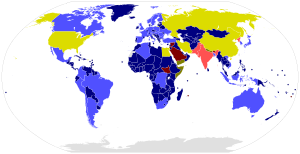
The Comprehensive Nuclear-Test-Ban Treaty (CTBT) is a multilateral treaty to ban nuclear weapons test explosions and any other nuclear explosions, for both civilian and military purposes, in all environments. It was adopted by the United Nations General Assembly on 10 September 1996, but has not entered into force, as eight specific nations have not ratified the treaty.

The Partial Test Ban Treaty (PTBT), formally known as the 1963 Treaty Banning Nuclear Weapon Tests in the Atmosphere, in Outer Space and Under Water, prohibited all test detonations of nuclear weapons except for those conducted underground. It is also abbreviated as the Limited Test Ban Treaty (LTBT) and Nuclear Test Ban Treaty (NTBT), though the latter may also refer to the Comprehensive Nuclear-Test-Ban Treaty (CTBT), which succeeded the PTBT for ratifying parties.

Infrasound, sometimes referred to as low frequency sound, describes sound waves with a frequency below the lower limit of human audibility. Hearing becomes gradually less sensitive as frequency decreases, so for humans to perceive infrasound, the sound pressure must be sufficiently high. The ear is the primary organ for sensing low sound, but at higher intensities it is possible to feel infrasound vibrations in various parts of the body.

Nuclear weapons tests are experiments carried out to determine the performance, yield, and effects of nuclear weapons. Testing nuclear weapons offers practical information about how the weapons function, how detonations are affected by different conditions, and how personnel, structures, and equipment are affected when subjected to nuclear explosions. However, nuclear testing has often been used as an indicator of scientific and military strength. Many tests have been overtly political in their intention; most nuclear weapons states publicly declared their nuclear status through a nuclear test.
The Comprehensive Nuclear-Test-Ban Treaty Organization (CTBTO) is an international organization that will be established upon the entry into force of the Comprehensive Nuclear-Test-Ban Treaty, a Convention that outlaws nuclear test explosions. Its seat will be in Vienna, Austria. The organization will be tasked with verifying the ban on nuclear tests and will operate therefore a worldwide monitoring system and may conduct on-site inspections. The Preparatory Commission for the CTBTO, and its Provisional Technical Secretariat, were established in 1997 and are headquartered in Vienna, Austria.

The Air Force Technical Applications Center (AFTAC), based at Florida's Patrick Space Force Base, is an Air Force surveillance organization assigned to the Sixteenth Air Force. Its mission is to monitor nuclear treaties of all applicable signatory countries. This is accomplished using seismic, hydroacoustic and satellite-detection systems alongside ground based and airborne materials collection systems.
An underwater explosion is a chemical or nuclear explosion that occurs under the surface of a body of water. While useful in anti-ship and submarine warfare, underwater bombs are not as effective against coastal facilities.

The 2006 North Korean nuclear test was the detonation of a nuclear device conducted by North Korea on October 9, 2006.

Underground nuclear testing is the test detonation of nuclear weapons that is performed underground. When the device being tested is buried at sufficient depth, the nuclear explosion may be contained, with no release of radioactive materials to the atmosphere.
The International Noble Gas Experiment (INGE) was formed in 1999 as an informal expert's group of developers of radioactive xenon measurement systems for the International Monitoring System for the Comprehensive Nuclear-Test-Ban Treaty (CTBT). The group originally consisted of research and development groups from Germany, France, Russia, Sweden, and the United States, as well as personnel from Provisional Technical Secretariat of the Preparatory Commission for the Comprehensive Nuclear-Test-Ban Treaty Organization CTBTO.
National technical means of verification (NTM) are monitoring techniques, such as satellite photography, used to verify adherence to international treaties. The phrase first appeared, but was not detailed, in the Strategic Arms Limitation Treaty (SALT) between the US and USSR. At first, the phrase reflected a concern that the "Soviet Union could be particularly disturbed by public recognition of this capability [satellite photography]...which it has veiled.". In modern usage, the term covers a variety of monitoring technologies, including others used at the time of SALT I.
Microbarometers are sensitive barometers that can measure air pressure with high precision. Microbarometers typically have a resolution of microbars (μbar) or pascals (Pa), while ordinary barometers can only resolve in hectopascals (hPa) or millibars (mbar). Recording microbarometers, or microbarographs, distributed around the world are planned to be used to monitor compliance with the Comprehensive Nuclear-Test-Ban Treaty by detecting the infrasound signature of a nuclear explosion, which can propagate for very long distances. By analyzing the data received at several of these monitoring stations, the location and yield of the explosion can be determined.
Timothy Hampton (1962–2009) was a specialist in weapons of mass destruction and an employee of the preparatory commission for the Comprehensive Nuclear-Test-Ban Treaty Organization (CTBTO) in Vienna, Austria since 1998.
Sulzberg is a mountain of Bavaria, Germany.
Forensic seismology is the forensic use of the techniques of seismology to detect and study distant phenomena, particularly explosions, including those of nuclear weapons.
The Conrad Observatory is an underground geophysical research facility of the Central Institution for Meteorology and Geodynamics (ZAMG) in Austria. The basic task of the observatory is monitoring relevant physical parameters that are of decisive importance for our understanding of processes on and below earth. At the Conrad Observatory, seismic activities (seismology), variations in gravitational acceleration and mass changes (gravimetry), magnetic field variations, geodetic parameters, atmospheric waves, as well as meteorological data are continuously monitored.

On 12 February 2013, North Korean state media announced it had conducted an underground nuclear test, its third in seven years. A tremor that exhibited a nuclear bomb signature with an initial magnitude 4.9 was detected by the China Earthquake Networks Center, Preparatory Commission for the Comprehensive Nuclear-Test-Ban Treaty Organization and the United States Geological Survey. In response, Japan summoned an emergency United Nations meeting for 12 February and South Korea raised its military alert status. It is not known whether the explosion was nuclear, or a conventional explosion designed to mimic a nuclear blast; as of two days after the blast, Chinese, Japanese, and South Korean investigators had failed to detect any radiation.

Lassina Zerbo is a Burkinabé politician and scientist who served as the Prime Minister of Burkina Faso from 2021 to 2022. Prior to that he was the Executive Secretary of the Comprehensive Nuclear-Test-Ban Treaty Organization. On 24 January 2022, Zerbo was deposed in a coup d'état.
A nuclear detonation detection system (NDDS) is a device or a series of devices that are able to indicate, and pinpoint a nuclear explosion has occurred as well as the direction of the explosion. The main purpose of these devices or systems was to verify compliance of countries that signed nuclear treaties such as the Partial Test Ban treaty of 1963 (PTBT) and the Treaty of Tlatelolco.














